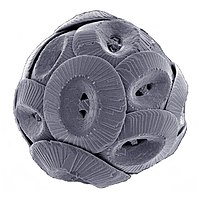
Photo from wikipedia
Abstract Bio-Argo measurements of the backscattering coefficient (bbp) were used to investigate the time-depth evolution of coccolithophore blooms in the Black Sea. Five years of Bio-Argo data obtained in 2014–2018… Click to show full abstract
Abstract Bio-Argo measurements of the backscattering coefficient (bbp) were used to investigate the time-depth evolution of coccolithophore blooms in the Black Sea. Five years of Bio-Argo data obtained in 2014–2018 revealed two distinct peaks of bbp corresponding to the winter and early summer coccolithophore blooms. The latter started in the upper mixed layer (UML) in April–May and was characterized by the highest coccolithophore concentrations. During the most extensive summer bloom in 2017, its estimates reach 10 × 106 cells l−1. The summer blooms occupied the UML (0–10 m) and a seasonal thermocline (10–30 m). The lower boundary of the bloom was related to the position of isopycnal 1014 kg m−3, which deepens in May–July due to summer heating. Consequently, the coccolithophore bloom deepened to 20–30 m and terminated rapidly in July. Bloom termination was accompanied by a significant rise in light attenuation (kd) in the sea basin. This peak was attributed to the release of dissolved organic carbon (DOC), which was possibly related to viral lysis and the exudation of lipids from coccolithophore cells. Data on the kd was used to estimate the seasonal variability in DOC in the Black Sea. Maximal estimated values of DOC were observed at 15–35 m depth in June-August and coincided with the early summer coccolithophore bloom termination. The winter coccolithophore bloom started in October–November in the UML. The maximum bbp was observed in January. High values of bbp were observed down to a depth of 60 m during the maximal deepening of the mixed layer. The winter blooms were distinctly observed in MODIS satellite images, where they were characterized by high reflectance and relatively low chlorophyll concentrations. The estimated coccolithophore concentration in winter was lower than that in summer, but column-averaged bbp values were comparable. The winter coccolithophore bloom reached a peak within one month after the autumn peak of chlorophyll A, indicating the possible importance of the nutrients recycled after the diatom autumn bloom. In contrast to summer, the maximum DOC observed at the surface preceded the winter coccolithophore bloom, and the mass DOC production was probably attributed to the excretion and lysis of the non-calcified phytoplankton cells.
Journal Title: Journal of Marine Systems
Year Published: 2019
Link to full text (if available)
Share on Social Media: Sign Up to like & get
recommendations!